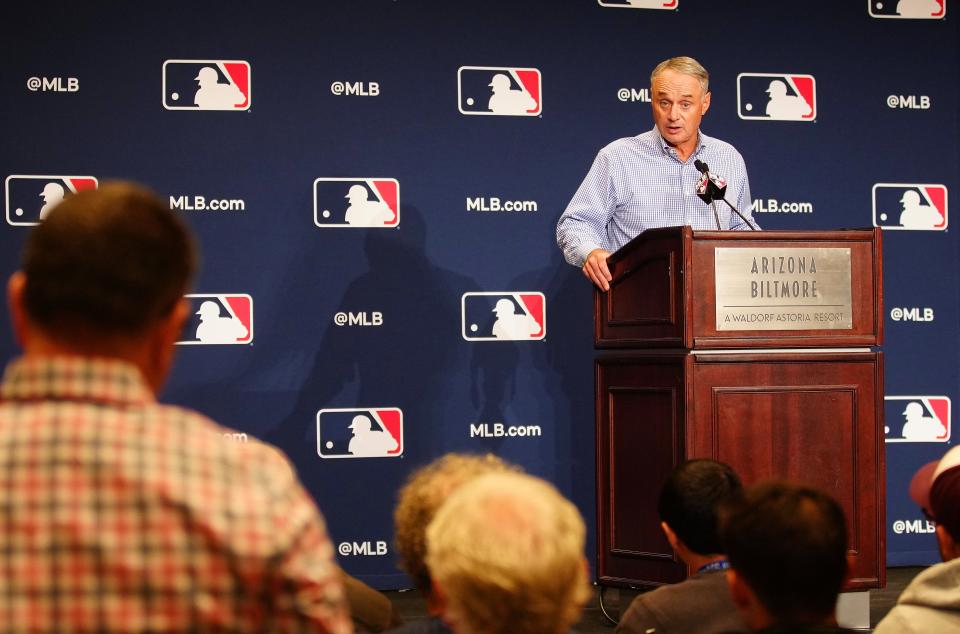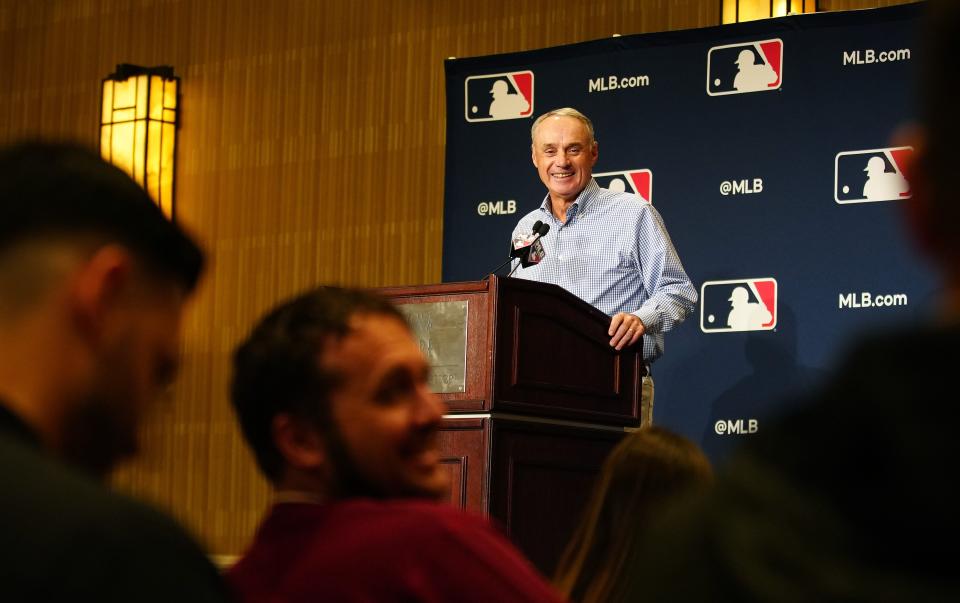MLB commissioner outlines future for Bally Sports deals amid bankruptcy speculation

Last month, Bloomberg reported that Diamond Sports Group, which operates Bally Sports, is expected to file for bankruptcy. The group missed a $140 million interest payment, that brought to light its financial struggles as consumers continue to forgo cable in favor of internet streaming providers.
For Major League Baseball, the impacts could be massive.
Fourteen clubs, including the Diamondbacks, have broadcast agreements with Bally Sports. League-wide, approximately 21% of MLB’s $10.8 billion in annual revenue comes from local broadcast agreements.
In the season-opening press conference on Wednesday, MLB commissioner Rob Manfred said that Diamond has told the league that it intends to pay its contracts for this season. Manfred also reiterated that, “our first choice would be that Diamond pay the clubs what they're contractually obligated to pay them.”
For the most part, though, the commissioner cut a realistic tone.
“It's hard to escape the reality that the change in media consumption has been particularly hard on the (regional sports networks),” Manfred said. “Obviously we want all of our broadcast partners to be successful, we don't want them to have financial difficulties. And we have been spending a lot of time and effort trying to work with Diamond to figure out exactly where they are.”
If Diamond is unable to pay teams, though, its broadcast agreements will be terminated.
On the clock: MLB breaks down new rules as new season looms
Manfred outlined the next steps in that scenario. For one, the league will step in to produce games through MLB Network. It would then go directly to television providers such as Comcast, Spectrum and DirecTV and make an agreement to have those games distributed.
While that outcome would create minimal disruption for fans, it could be massively impactful on MLB’s revenue. On Tuesday, Manfred admitted that teams would not be able to replace 100% of their revenue from regional sports networks.
One potential benefit, though, could come with a loosening of MLB.TV’s blackout restrictions. Currently, games on the league’s streaming service are blacked out in local markets. If Bally is unable to broadcast games, that could change.
“We would be seeking flexibility on the digital side so that when you look at MLB.TV, you'd go in, you could buy your out-of-market package like you've always had, but you'd have the option to buy up into in-market games, something that the fan has never had before, which I see as a huge improvement for fans,” Manfred said.
Manfred added that the removal of blackout restrictions would likely only be temporary, and would only impact teams whose broadcast agreements fell through.
Still, it provides a potential pathway for a permanent change. Essentially, the reason for the blackout rule is that it increases the price at which teams can sell their broadcast rights to regional sports networks. If 14 of those agreements are severed at once, the calculus for ending blackout restrictions league-wide becomes much simpler.
“In the last couple of years, if you had to say, give me one word that's central baseball's number one priority, that word would be reach,” Manfred said. “And blackouts are the opposite side of the coin of reach. We need to deliver product to fans who want to watch on platforms that they customarily use at a realistic price. That is our number one priority.”
Manfred, though, reiterated the importance of regional sports networks (known as RSNs) to baseball’s business model — with or without Bally.
“I think for a period of time, there will be a legacy cable bundle model, including RSNs,” Manfred said. “It's gonna be smaller than what we're used to, certainly smaller than it was in its heyday. But it's gonna remain significant because there's economics associated there that are important to the game.
“Eventually, it may go away but I don't think it's a short-term phenomenon. I think it's really important for the game to preserve the economics in the remaining RSN cable bundle while developing a digital alternative that has more flexibility and gives us better reach in terms of getting to fans who want to watch and don't have the ability to watch.”
Manfred addresses market imbalance
As the only major North American sports league without a salary cap, MLB has a unique disparity problem.
This season, the Mets’ payroll is estimated at $330.6 million, per Spotrac. Oakland’s is just 12% of that, at $40.9 million. Those teams aren’t exceptions, either. Eleven teams, including the Diamondbacks at $99.4 million, have payrolls estimated to be under $100 million. Six are at least twice that, over $200 million.

“Most people who pay attention to our game realize that we do have a disparity issue in the game, both on the revenue side and consequently on the ability to spend on players,” Manfred acknowledged.
The context of Manfred’s comment was a presentation in which Reds president Phil Castellini said that, on average, 14 teams are out of contention by the beginning of the season. Manfred called those, “unfortunate comments — not helpful.”
On the flip side, Manfred praised the investment from Padres owner Peter Seidler, whose team currently has the third-largest payroll in baseball despite playing in a small market.
“I think there's real positive in the Padres' story,” Manfred said. “I think that the investment that the club has made in talent has allowed them to grow their revenue to the point where they will be a payor under the revenue-sharing system this year. The trick for smaller markets has always been sustainability. Hats off to Peter Seidler, who has made a massive financial commitment, personally, to making this all happen.”
This article originally appeared on Arizona Republic: Manfred outlines what Bally bankruptcy could mean for MLB markets

